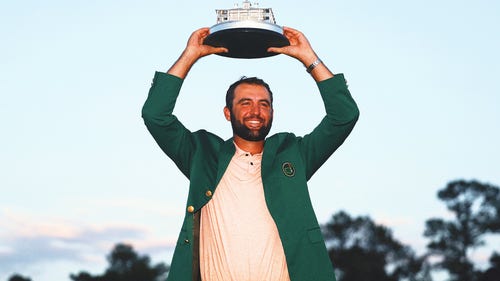
Anchored Putter Ban: One Year Later How Five Players Affected
Aug 13, 2015; Sheboygan, WI, USA; Adam Scott putts on the 16th green during the first round of the 2015 PGA Championship golf tournament at Whistling Straits. Mandatory Credit: Thomas J. Russo-USA TODAY Sports
Over a year has passed since the implementation of golf’s anchored putter ban – how has the ban impacted the players who anchored?
The anchored putter ban “prohibits anchoring a club when making a stroke”. Implemented on January 1, 2016, the rule sent shockwaves through the game, particularly among the professional ranks.
Many were sympathetic to the protests. The slightest advantage a golfer can find, like using a broomstick putter, can make the difference in one’s career.
“We’re not going to take away your long putter,” Mike Davis told Golf Digest. All you need to do . . . [is] control the whole club with your hands. So long and belly putters are still legal – as long as you don’t anchor them.”
The argument against anchored putters is based on the assumption that affixing the club to one’s body is an illegitimate way of gaining control of the putting stroke. The swinging motion consistent in all facets of golf is diminished.
Use of anchored putters increased after a streak of four of six major winners were anchoring their putters.
Anchored Putting – Arguments Pro & Con
The argument for anchoring is rooted in the belief that going to the anchored putter is a matter of comfort and preference. Certain players might improve from their traditional stroke, but that it is not necessarily a cure-all. Any success from the anchored putter comes from a place of skill or is psychological, but not from any sort of inherent advantage.
No concrete evidence documented a noticeable advantage gained from anchoring when the USGA and the R&A implemented the anchored putter ban..
Some assert that the anchored putter ban resulted from an outcry among a generation of golfers who preceded the popularization of alternative putters and equipment. As there was for the implementation of a 3-point line in basketball or instant replay, there will always be bristles about changes in a sport. Long putters have been around since the 1960s, but were often seen as a gimmicky novelty until they sprouted up more frequently in the 2000s.
The run of major champions with an anchored putting style was another likely factor in the decision. Keegan Bradley’s win at the 2011 PGA Championship ushered in a span of four of six major champions to use the alternative style. Webb Simpson, Ernie Els, and Adam Scott followed Bradley into the championship circle.
Let’s take a look at how the four major champs and a fifth wild card stack up since the rule change.
Keegan Bradley
May 10, 2013; Ponte Vedra Beach, FL, USA; Keegan Bradley putts for birdie on the 16th green in the second round at TPC Sawgrass – Stadium Course. Mandatory Credit: Brad Barr-USA TODAY Sports
Keegan Bradley was the first to win a major championship with an anchored putter.
Rule 14-1b never earned the nickname the “Keegan Bradley rule,” but maybe it should have. The PGA Tour rookie outlasted Jason Dufner’s collapse at Atlanta Athletic Club to win the 2011 PGA Championship. At his side, rather, his stomach, was his trusty long putter. A smattering of players had Tour wins using similar methods, but never a win on golf’s highest stage. Unintentionally, Bradley began a trend of major champions using a similar style.
It’s not like Bradley was setting the world on fire with his putter, though. He finished 105th on the PGA Tour in 2011 in strokes-gained (SG) putting. His two-win Rookie of the Year season was more a product of his distance off the tee (300.7 yards, 20th) and accuracy (.683 strokes-gained off the tee, 6th).
Bradley did have an improved putting week in Atlanta, but who doesn’t heat up at least a little bit on the greens in a major win?
His game hasn’t been the same since that fateful day. He’s won once since at the 2012 WGC-Bridgestone Invitational and none since switching to a conventional putter.
Bradley’s Game After the Anchored Putter Ban
Bradley was among those who bit the bullet to make the switch before the calendar flipped to 2016. He tried to get out in front of the issue, but instead found himself looking back.
“It frustrated me,” Bradley told Golf Digest in the summer of 2016. “In the back of your mind you’re always thinking, ‘Man if I still had it.’”
Bradley tinkered with different grips and putters. He occasionally reverted back to his original anchored belly putter while he still could. Bradley was a modest 47th in SG putting and 26th in total putting in 2014. While in transition, Bradley was heckled and deemed a cheater by some fans while hanging on to the belly putter. Confidence issues from the equipment change were inevitable. Perhaps issues from his weakened public perception played a factor, too.
His ball-striking remained fairly intact starting in 2015, but his plummet outside of the world top 100 (from as high as 10th in his career) was a product of a balky putter. He finished 128th in SG putting in 2015 and 183rd in 2016 with a traditional flatstick.
Bradley continues to struggle in this department in 2017. Despite a T4 at the Farmers Insurance Open in January, he checks in at No. 110 in SG putting through 12 rounds.
Webb Simpson
June 17, 2012; San Francisco, CA, USA; Webb Simpson lines up a putt on the 17th hole during the final round of the 112th U.S. Open golf tournament at The Olympic Club. Mandatory Credit: Kyle Terada-USA TODAY Sports
Webb Simpson has been outspoken of his disdain for the anchored putter ban.
Webb Simpson was among those unafraid to speak out in opposition to the proposed anchored putter ban.
“If you look at the facts, last year there was no one in the top 20 of strokes gained category that anchored a putter,” Simpson said in an Associated Press report in 2012.
Simpson used his trusty belly putter dating back to 2004 starting out at Wake Forest. He ranked inside the top 60 in SG in his first six years on Tour. He began to transition to a conventional putter in 2015 and his stats on the greens took a tumble.
Simpson’s Game After the Anchored Putter Ban
Simpson dropped from 34th in SG in 2014 to 165th the following year. A drop to 177 in 2016 appeared to spell doom for the four-time PGA Tour winner.
He’s still had a few chances to win, including a four-hole playoff loss to Hideki Matsuyama at the Waste Management Phoenix Open in February 2017. Nonetheless, he’s slipped further to 189th in SG early on in 2017. The once uber-consistent world No. 5 dipped as low as 90th.
His fall might have been worse had he not been solid elsewhere. Simpson was fourth in 2016 in strokes gained approaching the green and 11th in strokes gained around the green. Those numbers have held steady the past few years.
Simpson appears to have the chops to keep his PGA Tour card for years to come. Until he corrals the putter, though, his career might not bring much more.
Ernie Els
DUBAI, UNITED ARAB EMIRATES – FEBRUARY 05: Ernie Els of South Africa looks on from the 9th green during the second round of the Omega Dubai Desert Classic at the Emirates Golf Club on February 5, 2016 in Dubai, United Arab Emirates. (Photo by Warren Little/Getty Images)
Ernie Els has tried it all to cure his putting woes, including the belly putter.
Golf is a game of tinkering. Few embody that more than Ernie Els. The “Big Easy” has one of the sweetest swings in golf, but has struggled to replicate that rhythm on the green at times in his career.
His woes have particularly manifested as of late. Els’ 2015 season with the flatstick evoked the infamous y-word in golf (yips) from critics who saw him frequently three- and four-putt greens. The former world No. 1 finished an abysmal 173rd in SG putting.
He switched to a cross-handed grip and reaped dramatic results. Els finished 23rd in SG putting the next year. His newfound success still seemed a little tenuous, especially after his meltdown at Augusta. In his first hole at the Masters, Els lagged a 50-footer to six feet. Not bad. He needed six more putts to ultimately exit the green.
“I couldn’t get the putter back,” Els told the media after his round. “I was standing there, I’ve got a three-footer, I’ve made thousands of three-footers, and I just couldn’t take it back.”
Els Can’t Putt Consistently, With or Without Anchoring
His struggles predate the seven-putt. The former critic of anchored putters went to the dark side in search of success. Els had spells with the belly putter in the early 2010s. Like any other putting style he used, ups and downs followed. He didn’t experience a drastic improvement from anchored putting, finishing outside the top 100 in SG putting in 2011 and 2012.
Els’ win at the 2012 Open Championship using a belly putter fueled the growing fire among those with ruling power to institute a ban. Perhaps forgotten is Adam Scott’s bogey-bogey-bogey-bogey finish (while also using an anchored putter) that paved the way for Els. Els’ was no flamethrower on the greens, either.
He admitted he couldn’t have won the Open that year without his belly putter, but he still finished in the bottom 15 in strokes gained putting that week at Royal Lytham.
Els’ success with the anchored putter netted a big win, but it might have come at the right place and time in a career mixed with putting highs and lows. The anchored putter appeared to be just one of 13 clubs in the bag that week.
Adam Scott
Sep 22, 2016; Atlanta, GA, USA; Adam Scott reacts after putting the eighth green during the 2016 Tour Championship at East Lake Golf Club. Mandatory Credit: Brett Davis-USA TODAY Sports
Adam Scott has remained at an elite level since the anchor ban was implemented.
We didn’t see any anchored putter alums win a major in 2016, but Adam Scott had himself a nice year with a pair of wins and five more top-fives worldwide with a traditional putter. Scott held on to the broomstick putter that won him the 2013 Masters just about as long as he could through 2015.
Scott didn’t close out 2013 anywhere near the top of the PGA Tour in SG putting (108th), but it was a slight improvement from his days of finishing outside the top 150. That’s all it took for the elite ball-striker to break through.
He jumped all the way to 54th in SG putting in 2014, but dipped back down to 157th in 2015. Perhaps 2016 was a needed excuse to break from the broomstick.
Scott’s Game After the Anchored Putter Ban
It didn’t take long in 2016 to find the winner’s circle with the new club in the bag. He won the Honda Classic and WGC-Cadillac Championship in consecutive weeks in March.
Scott wasn’t ready to attribute his first win in two years to the putter alone. He is known more for his elite ball-striking, after all.
“I think everyone is guilty at some point of being pretty reactive to whatever happens, and time does pass quickly,” Scott said at the Honda Classic winner’s press conference. “If I came out at the back end of last year with the short putter and just had very mediocre results and no confidence and started really poorly this year, no confidence, I’d feel like I’m a long way behind that standard that was set.”
Now with a full year’s worth of data, he was correct to pump the brakes in assessing his putting woes being over. He made a meager jump to 129th in SG putting, but as has been the case throughout his career, his length and accuracy continue to lay the foundation for his success.
Tim Clark
Apr 11, 2014; Augusta, GA, USA; Tim Clark hits his tee shot on the 4th hole during the second round of the 2014 The Masters golf tournament at Augusta National Golf Club. Mandatory Credit: Jack Gruber-USA TODAY Sports
For most, anchored putters are a choice. For Tim Clark, it was his only option.
Just about any golfer who has sought out an unconventional putter or style has done so as a product of curiosity or need for change. They could give an anchored putter a try as they pleased, but never had to commit to it.
More from Pro Golf Now
Tim Clark has no such luxury. Clark was born with a disability that disallows him from supinating his wrists. He can swing a golf club fine, but simple tasks like holding a bowl of soup are difficult for Clark.
So is putting conventionally. In fact, it’s impossible.
“I can’t grip the club properly if it’s close to my body because I don’t have the means to tuck my elbows in,” Clark was quoted in a 2013 Sports Illustrated article.
Clark used a long putter for decades dating back to his junior days. The ban impacted his livelihood almost more than anyone, and he made that clear in his unsuccessful rally against it.
Few in his circles had a problem with his long putter helping to a win at the Players Championship in 2010. Little did he know that showing you could win with an anchored putter may have kept him from having the chance to win more. Just a few years later, the anchored putter ban debate was stoked.
Clark Needed the Anchoring Option
He spoke at a player’s meeting in San Diego, galvanizing many in attendance to come to his side. Clark’s influence might have been a factor when then-PGA Tour commissioner Tim Finchem expressed his opposition before the USGA and R&A followed through with the ban.
The two-time PGA Tour winner finished third on the PGA Tour in SG putting in an anomalous 2007, but never finished inside the top 40 any other year. He was known more for his accuracy off the tee and a proficiency around the greens when his ball-striking failed him.
Still, the anchored putter ban served as a likely death sentence for a career already hampered by injuries.
Clark gave it a go in 2016 with a newfangled AccuLock Ace Putter that looked like it was from a 2 a.m. Golf Channel infomercial. It actually worked at the Sony Open that January en route to a T13 finish.
He couldn’t follow it up the next week. In his last worldwide start, Clark missed the cut the next week at the Career Builder Challenge late in January 2016. No timetable is known for a potential return for the 41-year-old.
How do you feel about the anchored putting ban? Have the USGA and the R&A stepped into an area of the game where they don’t belong? Share your thoughts in the comment section.
This article originally appeared on










































































































































